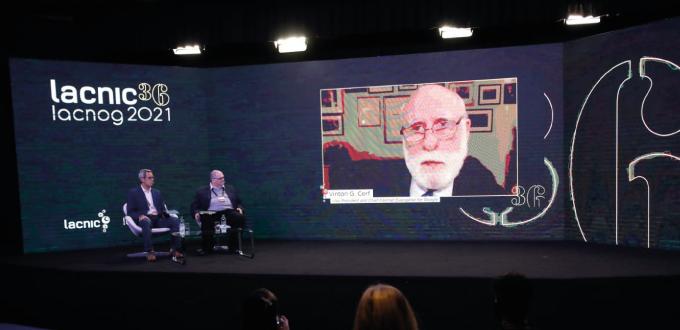Vint Cerf: Internet Success Factors and Challenges for the Next 50 Years
13/10/2021

Considered one of the fathers of the Internet, Vint Cerf gave an interview to LACNIC CEO Oscar Robles and LACNIC CTO Carlos Martínez as part of the opening of LACNIC 36 LACNOG 2021. During the interview, Vint Cerf analyzed the past, present, and future of the Internet.
Cerf recalled that, originally, each network had no concept of networks other than themselves and had address space that was specific to each network. “No matter what we did, we knew that we had to put a box around the network, but we knew that it was also part of this thing we called the Internet.” This led to the decision to design an Internet address space (what we now know as IP address space), create the Internet protocol layer, and encapsulate packets for the networks interconnected by what were then known as gateways. “At the time, Internet address space was not country-coded, it was purely topological and reflected how networks were connected to each other,” Cerf explained.
He pointed out that the Internet rapidly expanded in several dimensions thanks to the transport capacity of the protocol layer. Innovation in Internet protocol architecture was also allowed in both horizontal and vertical terms, so that when the World Wide Web was created and the hypertext transport protocol was introduced, it was simply layered on top of TCP and nothing else had to be changed. The same argument was also true in a horizontal sense, for example, when real-time communication protocols or other types of mechanisms were added. “They just occupy a different space in this protocol architecture and don’t disturb anybody because it’s just another type of protocol you can run vertically or horizontally,” Cerf added.
When asked if he had any regrets, Cerf replied that one of the mistakes they failed to correct in time was failing to adopt version 6 of the Internet Protocol (IPv6) earlier. “At that point, the Internet had been running for 13 years. In 1992 we realized that 4.3 billion IPv4 addresses were not going to be enough. I wish that we had been able to get everybody to use IPv6 right away and realize how useful IPv6 was before the network grew, but this was during the boom of the Internet bubble, so people had other things on their minds.”
Success Factors. According to Cerf, one of the key elements that have enabled Internet growth was the domain name system, which allowed an enormous expansion of the address space.
He also stressed that from the very beginning they “had worked in a collaborative and cooperative way, as having a central authority would have inhibited innovation in many dimensions. This distributed, non-hierarchical structure was very important for Internet success, and it still is.”
The next 50 years. According to Cerf, two of the most important events that took place and allowed the Internet to grow were the domain name system and the evolution of the gateway protocols that were developed in the early days of the Internet.
After a brief overview of the various technical elements involved, Robles and Martínez spoke with Cerf about the challenges that the Internet will face over the next 50 years. The first challenge Cerf mentioned was getting everyone online, as half the world still needs to be connected. He added that there appears to be no end to the number of applications people can invent, let alone limits to the flexibility of the Internet protocol architecture. “The best days of Internet are yet to come,” he stressed.
To illustrate this, he asked everyone to think about the data rates that can be achieved with fiber optic networks and the rapid growth of undersea cables and low-orbit satellites. These developments translate into the inability to escape the Internet, as it will reach every corner of the earth and the seas.
In Cerf’s opinion, the key for driving universal access will be cost. “How can we make the Internet affordable? Even if it’s present, if it’s not affordable, not everyone will be able to use it. And this involves not only the cost of access but also the cost of the equipment needed to connect and make use of the Internet as we know it,” Cerf concluded.